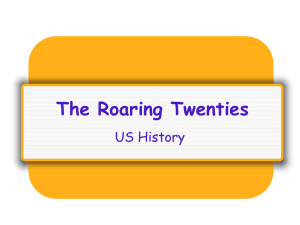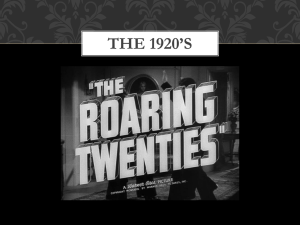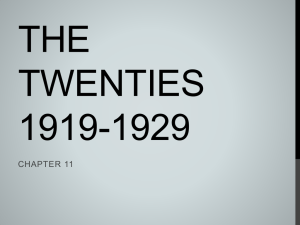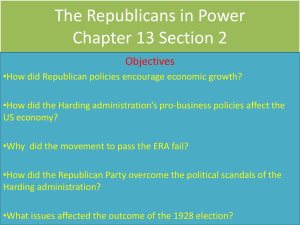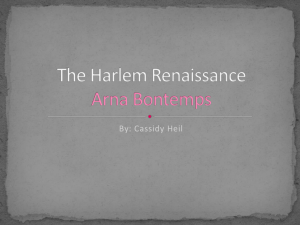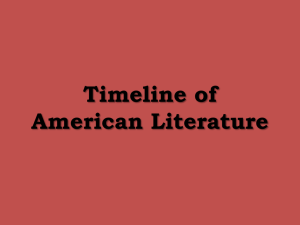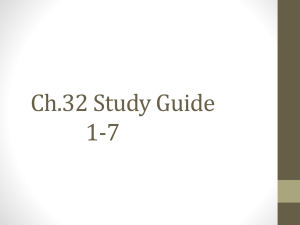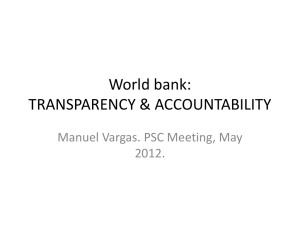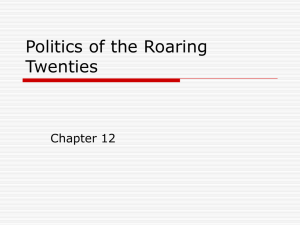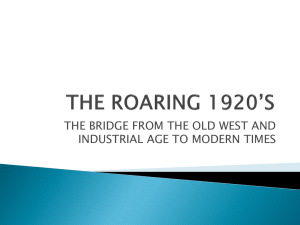The Roaring 20s
advertisement
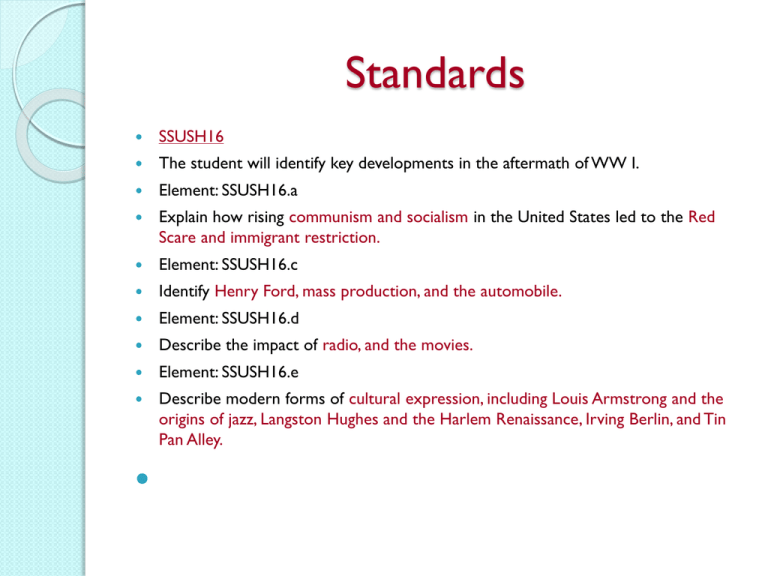
Standards SSUSH16 The student will identify key developments in the aftermath of WW I. Element: SSUSH16.a Explain how rising communism and socialism in the United States led to the Red Scare and immigrant restriction. Element: SSUSH16.c Identify Henry Ford, mass production, and the automobile. Element: SSUSH16.d Describe the impact of radio, and the movies. Element: SSUSH16.e Describe modern forms of cultural expression, including Louis Armstrong and the origins of jazz, Langston Hughes and the Harlem Renaissance, Irving Berlin, and Tin Pan Alley. The Roaring 20s Chapter 20 1919-1929 How did the United States experience both economic growth and social change in the decade after World War I? A Booming Economy The Automobile Drives Prosperity Main Idea: A large economic boom in the 1920s was sparked largely by the automobile industry. Henry Ford’s use of mass production and assembly lines lowered car prices and increased the number of Americans who owned cars. A Bustling Economy Main Idea: The economic growth of the 1920 impacted both consumers and the stock market. Cities, Suburbs, and Country Main Idea: Cities grew in population and size and improved transportation allowed suburbs to expand, but rural areas did not share in this growth. Continued… Postwar Adjustments Economic Adjustments ◦ Wartime demand dropped ◦ Soldiers faced unemployment ◦ Lower demand ◦ Higher cost of living ◦ Labor Unrest increased ◦ Discrimination against blacks A Booming Economy Section 1 How did the booming economy of the 1920s lead to changes in American life? Vocabulary: -Henry Ford consumer revolution -mass production installment buying -Model T bull market -assembly line buying on margin -scientific management A Consumer Economy Buying On Credit Age of Electricity Ford and the Automobile Effects on the rest of the economy Industrial growth Auto Drives Prosperity Henry Ford – assembly line: moving line brought car to the worker, who added parts; reduced production time for a Model T to 90 minutes Scientific management: process of hiring experts to improve mass production techniques Ordinary people could afford one GRAPH Economic Boom of the 1920s Changes in America Auto industry stimulated other industries related to car manufacture (insurance, steel, glass, rubber, asphalt, wood, gasoline, road construction) Other forms of transportation declined Appearance of service stations, diners, motels Sense of freedom Suburbs Consumer Revolution Advertising Consumer credit – installment buying Bull market, period of rising stock prices Buying on margin – borrowing money to buy stocks Cities, Suburbs, and Country People flock to cities Suburbs grow, draining people and resources from the cities Many Americans face hardship; farm incomes declined during the 1920s CHART Earnings of Agricultural Employees, 1918-1928 TRANSPARENCY New York City Skyline CHART Population of Selected U.S. Cities, 1910-1930 NOTE TAKING Reading Skill: Identify Supporting Details PM TRANSPARENCY Progress Monitoring Transparency The Business of Government Section 2 How did domestic and foreign policy change direction under Harding and Coolidge? Vocabulary: -Andrew Mellon Herbert Hoover -Calvin Coolidge Teapot Dome scandal -Washington Naval Disarmament Conference -Kellogg-Briand Pact -Dawes Plan The Business of Government The Harding Administration Main Idea: While in office, Harding reduced regulation of business and turned to others to make decisions, often leading to scandal. Coolidge Prosperity Main Idea: Coolidge supported big business, worked to reduce national debt, and oversaw a boom in the nation’s economy. However, he took no action against many social problems occurring at the time. America’s Role in the World Main Idea: World War I impacted American foreign policy in the 1920’s, as the government worked with other countries to collect war debts and prevent future wars. A Republican Decade Warren G. Harding ◦ Elected in 1920 ◦ Scandals ◦ Died August 3 1923 Calvin Coolidge ◦ Laissez Faire Capitalism “The business of the American people is business” ◦ Kellogg-Briand Pact Herbert Hoover 1928 Harding Administration Andrew Mellon – Secretary of the Treasury, advanced business interests Reduced spending from $18 billion to $3 billion Raised tariffs, weakening world economy Herbert Hoover – Secretary of Commerce, sought voluntary advancements between labor and business Political Scandals Warren G. Harding ◦ One of the worst Presidents in the history of the U.S. ◦ Advocated anti-lynching laws ◦ allowed Eugene Debs in the White House ◦ Harding’s cabinet was extremely corrupt Teapot Dome Scandal ◦ Worst of the scandals ◦ This 1924 cartoon shows the dimensions of the Teapot Dome scandal ANALYZE Political Cartoons: The Teapot Dome Scandal Republican Foreign Policy Harding Isolationism (leads to nativism) Disarmament – reducing the size and strength of the military Limiting Immigration – Quota for 350,000 people per year to immigrate Coolidge ◦ Kellogg-Briand Pact 1928 Aristide Briand and Frank. B. Kellogg signed the Kellogg-Briand Pact (Pact of Paris). The treaty outlawed war between France and the United States. The US Senate ratified it in 1929 and over the next few years 62 nations signed a similar agreement committing themselves to peace. Unenforceable Coolidge Prosperity Reduced the national debt Trimmed the federal budget Lowered taxes Boom economy Troubles brewing: -farmers struggled to keep land -labor unions -Discrimination Collecting War Debts U.S. refused to join the World Court Dawes Plan – U.S. make loans to Germany to pay reparation to Britain and France Britain and France repay debts to U.S. After crash of 1929, Germany stopped reparation payments, and Britain and France stopped paying the U.S. After World War II, the U.S. would be more flexible NOTE TAKING Reading Skill: Compare and Contrast TRANSPARENCY A Booming Economy QUICK STUDY The United States in International Affairs, 1920-1929 PM TRANSPARENCY Progress Monitoring Transparency Social and Cultural Tensions Section 3 How did Americans differ on major social and cultural issues? Vocabulary: -modernism -fundamentalism -Scopes Trial -18th Amendment -quota system Ku Klux Klan Prohibition Volstead Act Clarence Darrow bootlegger Social and Cultural Tensions Traditionalism and Modernism Clash Main Idea: In 1920 a noticeable divide appeared between urban and rural areas in the United States, as modern views spread in cities. Restricting Immigration Main Idea: Quota laws were passed limiting the number of immigrants who could enter the United States. The New Ku Klux Klan Main Idea: The Ku Klux Klan was revived, showing the anger some felt at the new shape America was taking. In addition to showing hatred to African Americans, it now also targeted Jews, Catholics, and immigrants. Prohibition and Crime Main Idea: Americans were divided over the Eighteenth Amendment, which made it illegal to manufacture or sell alcohol anywhere in the country, and many people continued to buy and sell alcohol. Traditionalism and Modernism More Americans in urban areas Urban Americans open to social change and science – modernism Rural Americans – more traditional view of religion, science, and culture Education Religious fundamentalism (Bible as literal truth) Clash over evolution CHART High School Education, 1900-1930 Science vs. Religion Debate Darwin’s Origin of Species Biblical Creation John T. Scopes ACLU – Clarence Darrow vs. William Jennings Bryant Arguments? Nativism refers to a widespread attitude in a society of a rejection of alien persons or culture ◦ Believed immigrants could not be fully loyal to the US ◦ Did not like Jews, Catholics, or Orthodox Christians ◦ City problems (slums,corruption) were blamed on the immigrants ◦ Immigrants meant competition for jobs ◦ Believed they carried dangerous political ideas Socialism, Anarchy, etc. Most of them came from very politically unstable countries National Origins Act Number of immigrants of a given nationality each year could not exceed 2 percent of the number of people of that nationality living in the U.S. in 1890 America had closed its “golden door” Nationwide Racial Discrimination ◦ Yellow Peril ◦ African Americans in the North ◦ Anti Semitic business practices ◦ Mexicans The New Ku Klux Klan ◦ White, Protestant, native born, Americans ◦ Hiram Wesley Evans – Imperial Wizard ◦ Over 4 million member in 1924 KKK Violence Rising Intolerance Prohibition 18th Amendment Volstead Act – enforced the amendment Stills, bootleggers Organized crime Al Capone TRANSPARENCY Political Cartoon: Prohibition NOTE TAKING Reading Skill: Contrast COMPARING VIEWPOINT Should a State Ban Teaching of Darwin’s Theory of Evolution? PM TRANSPARENCY Progress Monitoring Transparency A New Mass Culture Section 4 How did the new mass culture reflect technological and social changes? Vocabulary: -Charlie Chaplin Sigmund Freud -The Jazz Singer “Lost Generation” -Babe Ruth F. Scott Fitzgerald -Charles Lindbergh Ernest Hemingway A New Mass Culture New Trends in Popular Culture Main Idea: With more free time, Americans turned to movies, radio, and the phonograph as entertainment, creating a mass popular culture for the first time. An Age of Heroes Main Idea: Newspapers and radios allowed athletes and other figures of the time to become heroes to the American public. Women Assume New Roles Main Idea: Women’s roles changed as they were given more social and political opportunities. Modernism in Art and Literature Main Idea: After World War I, writers and artists developed new styles and ideas that appeared in their works. Society in the 1920s New Trends in Popular Culture More Leisure Time -Work week decreased Movies -Silent films: Charlie Chaplin -”Talkies”: The Jazz Singer Radio, phonograph Mass Media Newspapers ◦ Between 1920 and 1930circulation rose from 27.8 million to almost 40 million Motion Pictures ◦ Moviemaking became the 4th largest business in the country ◦ 1922 40 million viewers per week, 1930, 90 million per week Radio ◦ NBC ◦ Medium for the masses ◦ United the country…Why? American Heroes Lucky Lindy Amelia Earhart Jack Dempsey Babe Ruth and Lou Gehrig Gertrude Ederle Helen Wills NOTE TAKING Reading Skill: Summarize NOTE TAKING Reading Skill: Summarize The Harlem Renaissance A New “Black Consciousness” Main Idea: To deal with the racial problems African Americans continued to face, Marcus Garvey started a movement for black nationalism. The Jazz Age Main Idea: Jazz, a hybrid of African American and European music forms, originated in the South and spread quickly across the country, becoming a symbol of the twenties. The Harlem Renaissance Main Idea: African American writers and artists expressed racial and cultural views, leaving a lasting impact on how all Americans viewed African Americans. The Flapper and Changes for Women Style ◦ “bobbed” their Hair ◦ Wore makeup and shorter dresses ◦ Smoked and drank in public Work and Politics ◦ Women moved into office, sales, and professional jobs ◦ Voted in local and national elections ◦ Elected to political office Charles Lindbergh May 1927, Lindbergh took off from Long Island, New York Spirit of St. Louis In 33 hours, he landed in Paris Lone Eagle Modernism in Art and Literature Abstract styles in art Literature: “Lost Generation” QUICK STUDY American Postwar Novelists PM TRANSPARENCY Progress Monitoring Transparency The Harlem Renaissance Section 5 How did African Americans express a new sense of hope and pride? Vocabulary: -Marcus Garvey Claude McKay -jazz Louis Armstrong -Langston Hughes Bessie Smith -Zora Neale Hurston -Harlem Renaissance Marcus Garvey and Black Pride Alternative solutions to accepting white supremacy “the first man to give millions of Negroes a sense of dignity and destiny” MLK Black Pride Published the Negro World Black Eagle Flying Corps Empower blacks worldwide toward economic, religious, psychological, and cultural independence Believed in racial separatism The Jazz Age Jazz Clubs Music emerged from New Orleans ◦ 500 clubs in Harlem alone ◦ Cotton Club, Connie’s Inn, The Saratoga Club ◦ Jelly Roll Morton Band, Louis Armstrong (Satchmo), Duke Ellington, Bessie Smith Harlem Renaissance African American Literary awakening Langston Hughes Zora Neale Hurston NOTE TAKING Reading Skill: Identify Main Ideas TRANSPARENCY The Harlem Renaissance PM TRANSPARENCY Progress Monitoring Transparency
